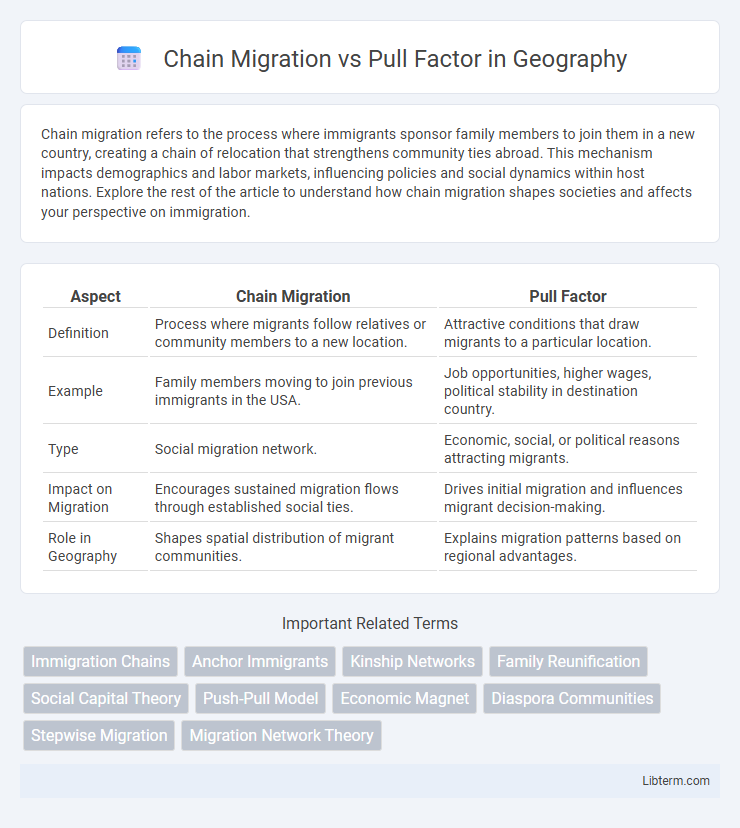Chain migration refers to the process where immigrants sponsor family members to join them in a new country, creating a chain of relocation that strengthens community ties abroad. This mechanism impacts demographics and labor markets, influencing policies and social dynamics within host nations. Explore the rest of the article to understand how chain migration shapes societies and affects your perspective on immigration.
Table of Comparison
| Aspect | Chain Migration | Pull Factor |
|---|---|---|
| Definition | Process where migrants follow relatives or community members to a new location. | Attractive conditions that draw migrants to a particular location. |
| Example | Family members moving to join previous immigrants in the USA. | Job opportunities, higher wages, political stability in destination country. |
| Type | Social migration network. | Economic, social, or political reasons attracting migrants. |
| Impact on Migration | Encourages sustained migration flows through established social ties. | Drives initial migration and influences migrant decision-making. |
| Role in Geography | Shapes spatial distribution of migrant communities. | Explains migration patterns based on regional advantages. |
Understanding Chain Migration: Definition and Mechanisms
Chain migration refers to the process where immigrants from a particular community or family sponsor relatives to join them in a new country, creating a network effect that facilitates further migration. This mechanism relies on social ties and established support systems, allowing new migrants to access housing, jobs, and cultural familiarity more easily. Understanding chain migration highlights how personal relationships and legal pathways intertwine to shape migration patterns and influence demographic changes in host countries.
What Are Pull Factors in Migration?
Pull factors in migration refer to the positive attributes or conditions of a destination that attract individuals to relocate, such as economic opportunities, political stability, better living standards, and available social services. These factors play a crucial role in migration decisions by offering incentives like higher wages, improved education, and safety from conflict or persecution. Understanding pull factors helps explain migration flows and the appeal of certain countries or regions over others.
Chain Migration vs Pull Factor: Key Differences
Chain migration involves the movement of immigrants who follow family or community members to a new location, driven by established social networks. Pull factors refer to external conditions such as economic opportunities, political stability, or better living standards that attract individuals to migrate to a particular destination. The key difference lies in chain migration being network-driven and relational, whereas pull factors are environmental or situational incentives influencing migration decisions.
Historical Contexts: Case Studies of Chain Migration
Chain migration historically shaped immigration patterns by enabling established migrants to sponsor family members, exemplified by Italian migration to the United States in the late 19th and early 20th centuries. Case studies reveal how chain migration created ethnic enclaves that facilitated cultural retention and economic opportunities, as seen in New York's Little Italy. Pull factors, such as labor demand and economic prospects, interacted with chain migration by providing the initial conditions attracting primary migrants who then initiated these familial networks.
Economic Pull Factors: Work, Wages, and Opportunities
Economic pull factors such as higher wages, abundant job opportunities, and improved working conditions significantly drive migration patterns, attracting individuals to regions with stronger labor markets. Chain migration amplifies these effects by enabling migrants to leverage familial networks to secure employment and housing more efficiently in destination areas. This synergy between economic incentives and social connections accelerates integration and economic mobility for migrant communities.
The Role of Family Ties in Chain Migration
Family ties serve as a critical pull factor in chain migration, enabling newcomers to rely on established social networks for housing, employment, and emotional support. These connections facilitate smoother integration and reduce migration risks by providing essential resources and guidance. Strong familial bonds act as conduits for information flow, making specific destinations more attractive for subsequent migrants.
Government Policies Influencing Pull Factors
Government policies play a crucial role in shaping pull factors that attract migrants by offering visa preferences, family reunification programs, and economic opportunities. Chain migration is often facilitated through policies that allow immigrants to sponsor relatives, creating established networks that ease new arrivals' integration. Economic incentives, labor market demands, and social welfare systems serve as significant pull factors, influenced directly by legislative decisions and immigration regulations.
Social Networks and Community Support Systems
Chain migration leverages existing social networks, enabling immigrants to rely on established community support systems for housing, employment, and cultural integration. Social networks act as pull factors by providing reliable information, emotional support, and resources that reduce the uncertainties of relocation. Community support systems foster social capital, facilitating smoother transitions and encouraging further migration within connected groups.
Impacts of Chain Migration on Host Societies
Chain migration significantly influences host societies by fostering ethnic enclaves that contribute to cultural diversity and economic growth through entrepreneurial activities. This migration pattern can increase demand for social services and housing, potentially straining public resources and infrastructure. The presence of established migrant communities often facilitates social integration but may also lead to segmented labor markets and challenges in social cohesion.
Policy Implications: Balancing Chain Migration and Pull Factors
Policy implications of balancing chain migration and pull factors require nuanced immigration strategies that manage family reunification alongside economic migration incentives. Effective frameworks prioritize selective criteria to harness the benefits of established immigrant communities while regulating socioeconomic pull factors such as labor market demands and welfare access. Governments must continuously adapt policies to mitigate challenges like unauthorized migration and integration pressures, ensuring sustainable demographic and economic outcomes.
Chain Migration Infographic

 libterm.com
libterm.com